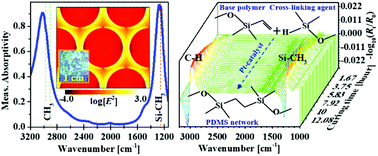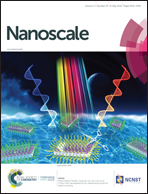Dual-band in situ molecular spectroscopy using single-sized Al-disk perfect absorbers†
Abstract
We propose antenna-enhanced infrared vibrational spectroscopy by adopting single-sized Al disks on Al2O3-Al films fabricated by colloidal-mask lithography. The precisely designed plasmonic resonator with dual-band perfect absorption (DPA) shows strongly-enhanced nearfield intensity and polarization independence, at both resonances, providing a powerful antenna platform for the multi-band vibrational sensing. As a proof of concept, we experimentally apply the plasmonic DPAs in bond-selective dual-band infrared sensing of an ultrathin polydimethylsiloxane (PDMS) film, simultaneously amplifying two representative vibrational bands (asymmetric C–H stretching of CH3 at 2962 cm−1 and CH3 deformation of Si–CH3 at 1263 cm−1) by surface-enhanced infrared absorption spectroscopy (SEIRA). The plasmonic DPA was successfully adopted for the in situ monitoring of reaction kinetics, by recording the spectral changes in C–H stretching and Si–CH3 deformation modes of a 10 nm PDMS elastomer, which are selectively enhanced by the two antenna resonances, during its gelation process. Our systematic study of the SEIRA spectra has demonstrated mode splitting and a clear avoided-crossing in the dispersion curve as a function of resonance frequency of DPA, manifesting itself as a promising basis for future polaritonic devices utilizing the hybridization between the molecular vibrational states and the enhanced light field.



 Please wait while we load your content...
Please wait while we load your content...
